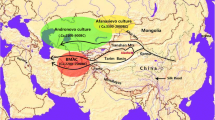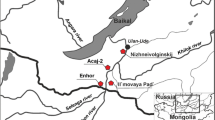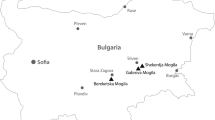Abstract
The Yuansha site is located in the center of the Taklimakan Desert of Xinjiang, in the southern Silk Road region. MtDNA was extracted from fifteen human remains excavated from the Yuansha site, dating back 2,000–2,500 years. Analysis of the phylogenetic tree and the multidimensional scaling (MDS) reveals that the Yuansha population has relatively close relationships with the modern populations of South Central Asia and Indus Valley, as well as with the ancient population of Chawuhu.
Similar content being viewed by others
References
Han K X. Anthropological research of ancient populations in Xinjiang and physical characteristics of Uigur. West Region Res, 1991, 2: 1–13
Comas D, Calafell F, Mateu E, et al. Trading genes along the silk road: mtDNA sequences and the origin of Central Asian populations. Am J Hum Genet, 1998, 63: 1824–1838
Comas D, Plaza S, Wells R S, et al. Admixture, migrations, and dispersals in Central Asia: Evidence from maternal DNA lineages. Eur J Hum Genet, 2004, 1–10
Calafell F, Comas D, Pe’rez-Lezaun A, et al. Genetics and population history of Central Asia. Cambridge: McDonald Institute for Archaeological Research, 2000
Francalacci P. DNA analysis of ancient desiccated corpses from Xinjiang. J Indoeur Stud, 1995, 23: 385–389
Francalacci P. DNA analysis on ancient desiccated corpses from Xinjiang (China): Further results. Washington, DC: Institute for the Study of Man, 1998
Lalueza-Fox C, Sampietro M L, Gilbert M T P, et al. Unravelling migrations in the steppe: mitochondrial DNA sequences from ancient Central Asians. Proc R Soc Lond B, 2004, 271: 941–947
Mallory J P, Mair V H. The Tarim mummies. London: Thames and Hudson, 2000
Li S. The interaction between Northwest China and Central Asia during the second millennium B.C.: An archaeological perspective. In: Boyle K, Renfrew C, Levine M, eds. Ancient Interactions: East and West in Eurasia. Cambridge, McDonald Institute for Archaeological Research, 2002. 171–182
Barber E W. The mummies of Ürümchi. New York: Norton, 1999
Lin M C. Origin and migration of Tocharian. West Region Res, 2003, 3: 9–23
Han K X. The physical anthropology of the ancient populations of the Tarim Basin and surrounding areas. In: Mair V H, eds. The Bronze Age and early Iron Age peoples of eastern Central Asia. Philadelphia, University of Pennsylvania Museum Publications, 1998. 558–570
Yao Y G, Kong Q P, Wang C Y, et al. Different matrilineal contributions to genetic structure of ethnic groups in the silk road region in China. Mol Biol Evol, 2004, 21: 2265–2280
O’Rourke D H, Hayes M G, Carlyle S W. Ancient DNA studies in physical anthropology. Ann Rev Anthropol, 2000, 29: 217–242
Higgins D, Sharp G. CLUSTAL: A package for performing multiple sequence alignment on a microcomputer. Gene, 1988, 73: 237–244
Saitou N, Nei M. The neighbor-joining method: A new method for reconstructing phylogenetic trees. Mol Biol Evol, 1987, 4: 406–425
Andrews R M, Kubacka I, Chinnery P F, et al. Reanalysis and revision of the Cambridge reference sequence for human mitochondrial DNA. Nat Genet, 1999, 23: 147
Finnilä S, Lehtonen M S, Majamaa K. Phylogenetic network for European mtDNA. Am J Hum Genet, 2001, 68: 1475–1484
Yao Y G, Kong Q P, Bandelt H J, et al. Phylogeographic differentiation of mitochondrial DNA in Han Chinese. Am J Hum Genet, 2002, 70: 635–651
Horai S, Murayama K, Hayasaka K, et al. MtDNA polymorphism in East Asian populations, with special reference to the peopling of Japan. Am J Hum Genet, 1996, 59: 579–590
Yao Y G, Nie L, Harpending H, et al. Genetic relationship of Chinese ethnic populations revealed by mtDNA sequence diversity. Am J Phys Anthropol, 2002, 118: 63–76
Tajima A, Hayami M, Tokunaga K, et al. Genetic origins of the Ainu inferred from combined DNA analyses of maternal and paternal lineages. J Hum Genet, 2004, 49: 187–193
Kolman C J, Sambughin N, Bermingham E. Mitochondrial DNA analysis of Mongolian populations and implications for the origin of New World founders. Genetics, 1996, 142: 1321–1334
Yao Y G, Lv X M, Luo H R, et al. Gene admixture in the Silk Road region of China-evidence from mtDNA and melanocortin I receptor polymorphism. Genes Genet Syst, 2000, 75: 173–178
Quintana-Murci L, Chaix R, Wells R S, et al. Where West Meets East: The complex mtDNA landscape of the Southwest and Central Asian Corridor. Am J Hum Genet, 2004, 74: 827–845
Kivisild T, Rootsi S, Metspalu M, et al. The genetic heritage of the earliest settlers persists both in Indian tribal and caste populations. Am J Hum Genet, 2003, 72: 313–332
Comas D, Calafell F, Mateu E, et al. Geographic variation in human mitochondrial DNA control region sequence: The population history of Turkey and its relationship to the European populations. Mol Biol Evol, 1996, 13: 1067–1077
Pult I, Sajantila A, Simanainen J, et al. Mitochondrial DNA sequences from Switzerland reveal striking homogeneity of European populations. Biol Chem Hoppe Sayler, 1994, 375: 837–840
Di Rienzo A, Wilson A C. Branching pattern in the evolutionary tree for human mitochondrial DNA. Proc Natl Acad Sci USA, 1991, 88: 1597–1601
Piercy R, Sullivan K M, Benson N, et al. The application of mitochondrial DNA typing to the study of white Caucasian genetic identification. Int J Legal Med, 1993, 106: 85–90
Wang C, Cui Y Q, Duan R H, et al. The ressearch of the Neolithic bones from the Jiangjialiang site, Yangyuan, Hebei Province. Archaeology, 2001, 654: 74–81
Christine K T, Eric C, Bertrand L. Nuclear and Mitochondrial DNA Analysis of a 2000-year-old Necropolis in the Egyin Gol Valley of Mongolia. Am J Hum Genet, 2003, 73: 247–260
Cui Y Q, Duan R H, Zhou H, et al. Analysis of genetical structure of ancient Xinjiang population. Chem J Chin U, 2002, 23: 2270–2280
Cui Y Q, Duan R H, Zhou H, et al. Analysis of mitochondrial DNA from the ancient tombs of Turfan. Chem Res Chin U, 2002, 18: 419–423
Xie C Z, Liu S B, Cui Y Q, et al. Analysis of mitochondral DNA from the ancient tombs of Chawuhu. J Jilin Univ (science edition), 2005, 43: 538–540
Hemphill B E and Mallory J P. Horse-mounted invaders from the Russo-Kazakh steppe or agricultural colonists from western central Asia? A craniometric investigation of the Bronze Age settlement of Xinjiang. Am J Phys Anthropol, 2004, 124: 199–222
Author information
Authors and Affiliations
Corresponding author
Additional information
Supported by the National Natural Science Foundation of China (Grant No. J0530184) and the “985” Foundation of Jilin University
Rights and permissions
About this article
Cite this article
Gao, S., Cui, Y., Yang, Y. et al. Mitochondrial DNA analysis of human remains from the Yuansha site in Xinjiang, China. Sci. China Ser. C-Life Sci. 51, 205–213 (2008). https://doi.org/10.1007/s11427-008-0034-8
Received:
Accepted:
Issue Date:
DOI: https://doi.org/10.1007/s11427-008-0034-8




